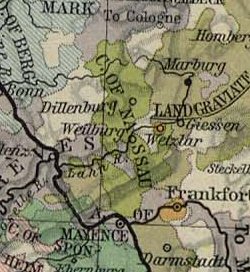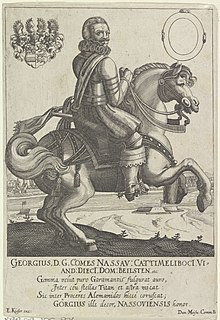
The County of Nassau was a German state within the Holy Roman Empire and later part of the German Confederation. Its ruling dynasty, the male line of which is now extinct, was the House of Nassau.

Frederick Henry was the sovereign prince of Orange and stadtholder of Holland, Zeeland, Utrecht, Guelders, Overijssel in the Dutch Republic from 1625 until his death in 1647. In the last seven years of his life, he was also the stadtholder of Groningen (1640-1647).

The House of Nassau is a diversified aristocratic dynasty in Europe. It is named after the lordship associated with Nassau Castle, located in present-day Nassau, Rhineland-Palatinate, Germany. The lords of Nassau were originally titled "Count of Nassau", then elevated to the princely class as "Princely Counts". Early on they divided into two main branches: the elder (Walramian) branch, that gave rise to the German king Adolf, and the younger (Ottonian) branch, that gave rise to the Princes of Orange and the monarchs of the Netherlands.
Otto I of Nassau, German: Otto I. von Nassau was Count of Nassau and is the ancestor of the Ottonian branch of the House of Nassau.
Georg Ernst of Limburg Stirum, count of Limburg Stirum, count of Bronckhorst, Lord of Wisch, Lichtenvoorde and Wildenborch, son of Jobst of Limburg.

Countess Anna of Nassau was a daughter of William the Silent and his second wife, Anna of Saxony. She was the wife of William Louis, Count of Nassau-Dillenburg.

John VIII, Count of Nassau-Siegen was a German nobleman and militarist of the 17th century.

Henry I of Nassau-Siegen, German: Heinrich I. von Nassau-Siegen was Count of Nassau-Siegen, a part of the County of Nassau, and ancestor of the House of Nassau-Siegen. He comes from the Ottonian branch of the House of Nassau.

John Louis of Nassau-Hadamar

Louis Henry of Nassau-Dillenburg, was Count, and from 1654 Prince of Nassau-Dillenburg. During the Thirty Years' War, he was a senior officer. He climbed to the rank of Major General. Before 1635, he served on the Protestant side; after 1635, he served in the imperial army.
Count Louis I of Nassau-Weilburg was a son of Count John III of Nassau-Weilburg and his wife, Elisabeth of Hesse. In 1492, Louis I succeeded his grandfather Philip II as Count of Nassau-Weilburg, because his father had already died in 1480.

Count George of Nassau-Beilstein, later also Count of Nassau-Dillenburg, was the third son of Count John VI "the Elder" of Nassau-Dillenburg (1536-1606) from his first marriage with Elisabeth of Leuchtenberg,
Katharina of Nassau-Beilstein was Countess of Hanau by marriage to Reinhard II, Count of Hanau, and regent of Hanau during the minority of her son Reinhard III from 1452 until 1458.
Henry II, Count of Nassau-Beilstein was the eldest son of Henry I and his wife, Imagina of Westerburg. He succeeded his father in 1388 as Count of Nassau-Beilstein and ruled jointly with his younger brother Reinhard.
John III, Count of Nassau-Beilstein was a son of John II and his wife Maria of Solms-Braunfels.
Emicho I, Count of Nassau-Hadamar, was the second son of Count Otto I of Nassau and his wife Agnes, the daughter of Count Emich IV of Leiningen-Landeck. Emicho was the founder of the elder line of Nassau-Hadamar. He was a cousin of King Adolf of Germany. He and his brother Henry fought on Adolf's side in the Battle of Göllheim on 2 July 1298.

Louis I, Count of Sayn-Wittgenstein, nicknamed "the Elder", formally "Louis I of Sayn, Count at Wittgenstein" ruled the County of Wittgenstein, on the upper reaches of the rivers Lahn and Eder, from 1558 until his death. He converted his county to Calvinism and was an influential politician in the service to the Electoral Palatinate.
John II, Count of Nassau-Beilstein was a son of Count Henry IV and his wife, Eva of Sayn. His father was son of John I which in turn was son of Henry II, Count of Nassau-Beilstein.
John, Count of Nassau-Dillenburg was the third son of Count Otto I of Nassau and his wife Agnes, daughter of Count Emich IV of Leiningen-Landeck. John was a first cousin of King Adolf of the Romans.

Lichtenstein Castle is a levelled spur castle on the hill of Burgberg Lichtenstein, 315 m above sea level (NN), near the Greifenstein village of Holzhausen on the old military High Road, that ran from Frankfurt via Wetzlar to Cologne. The castle site is situated to the north of, and above, the Ulmbach Reservoir in the Hessian county of Lahn-Dill-Kreis.










